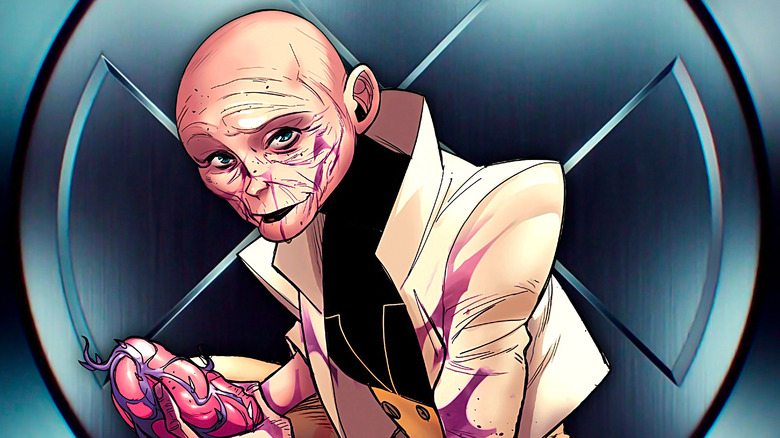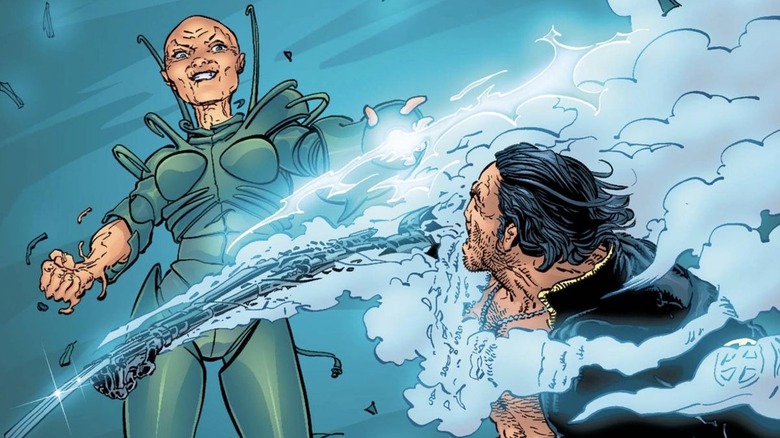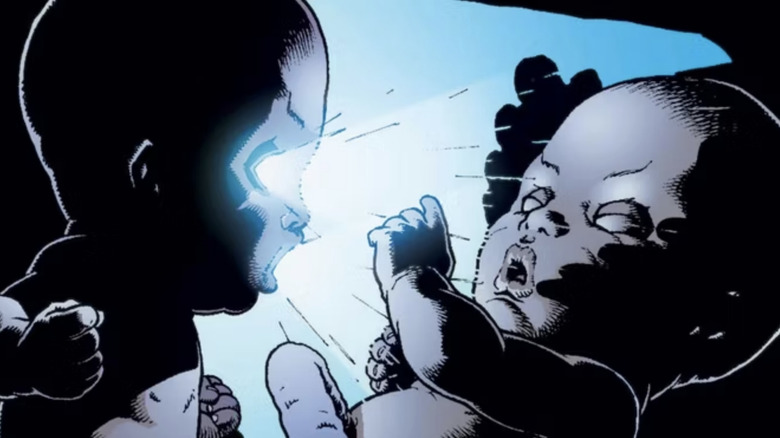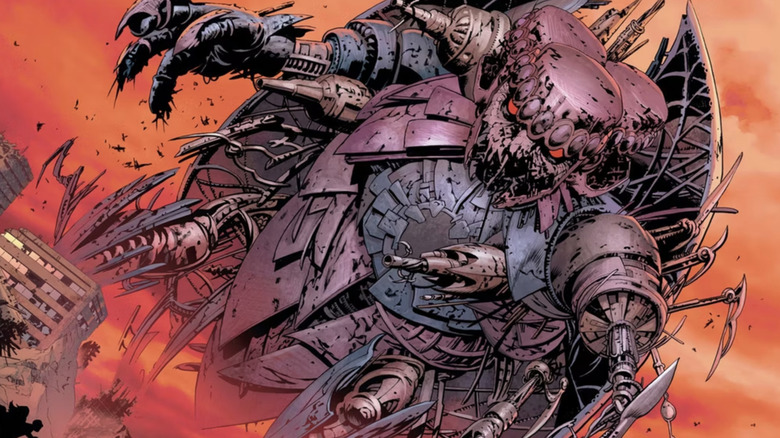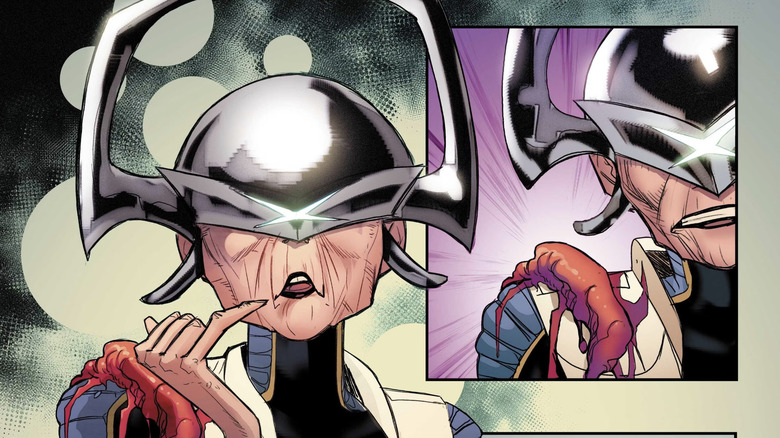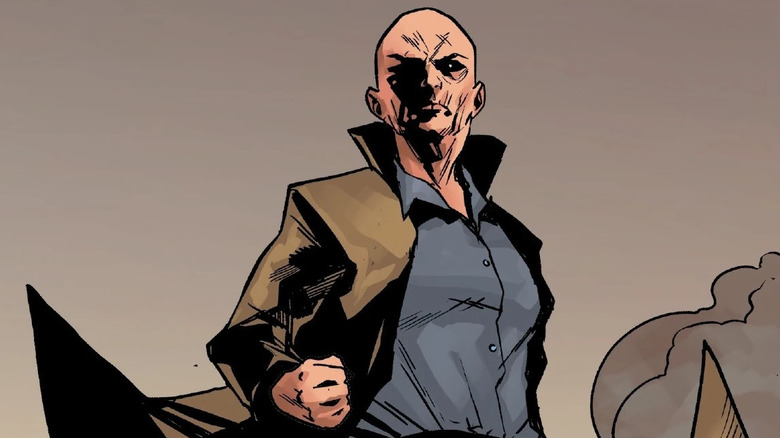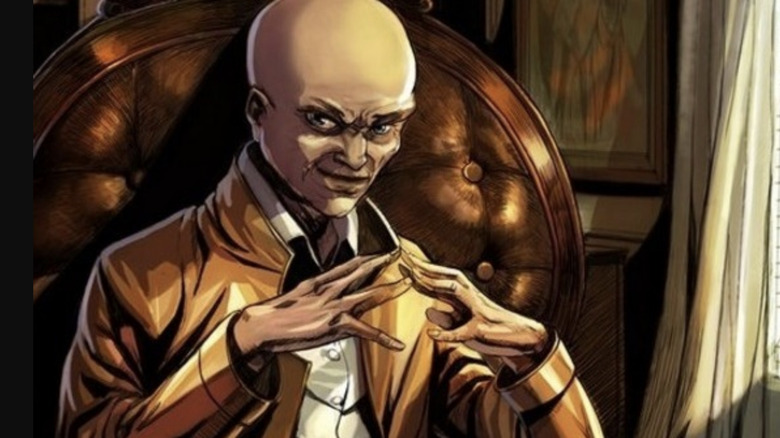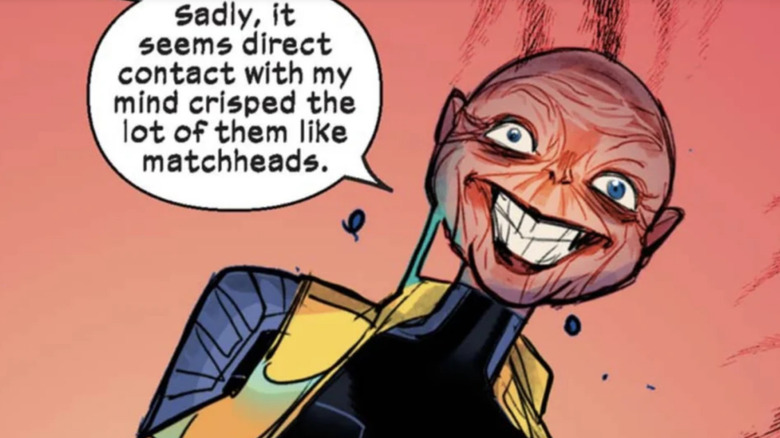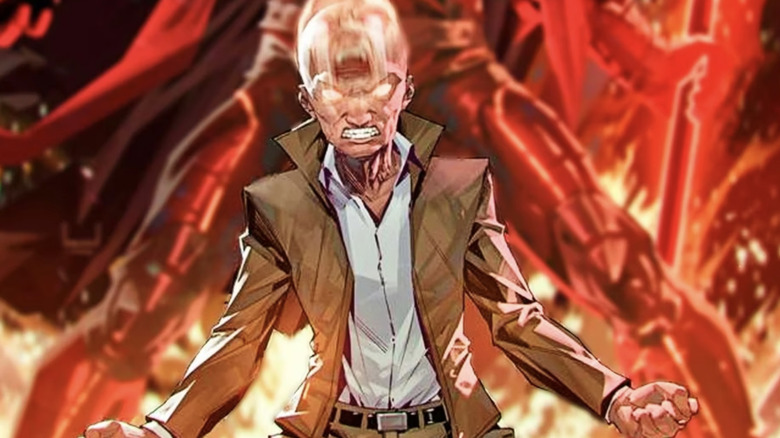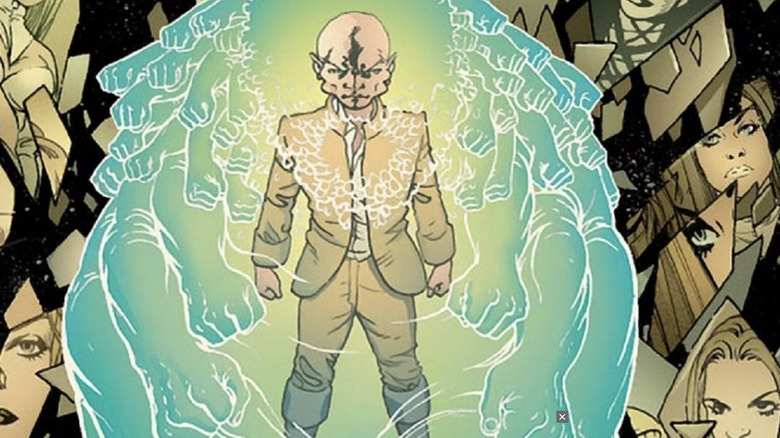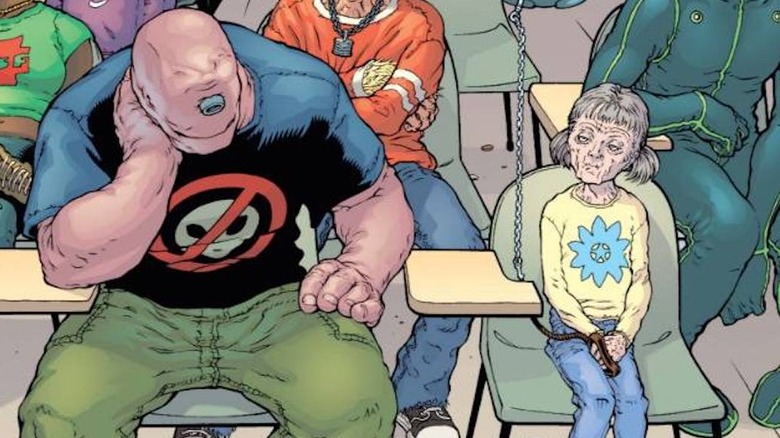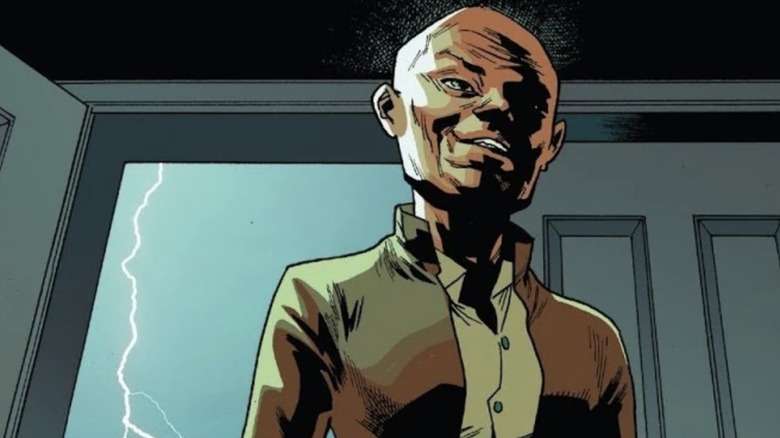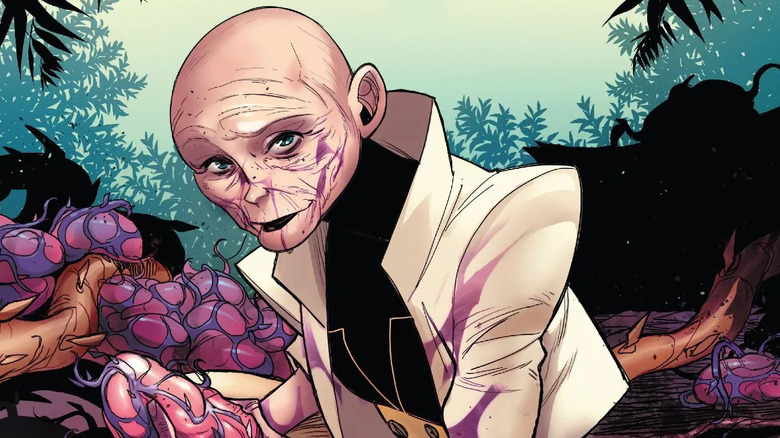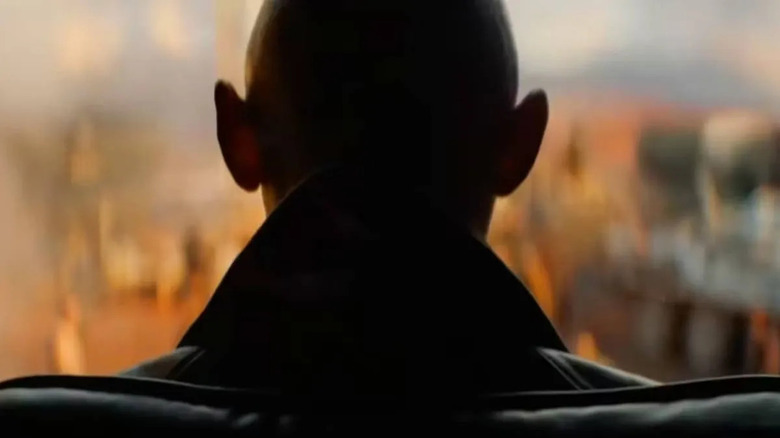The Untold Truth Of X-Men Villain Cassandra Nova
Marvel Comics has made famous some of the most iconic villains in all of pop culture, names that have reverberated across generations. From Doctor Doom to the Green Goblin, many of these big baddies have been brought to life on-screen, too, in live-action TV shows, animated cartoons, and big-budget movies. But for every famous nefarious face, there are a dozen more that have yet to be recognized outside of the comics themselves.
One such villain that has been menacing heroes in the Marvel Universe for the past two decades is Cassandra Nova, an enigmatic foe from the pages of "X-Men." With deep ties to Professor Charles Xavier himself, Nova may be among the most powerful villains the X-Men have ever faced, and yet outside of diehard fandom, few have ever heard of her. That's all about the change, though, as the villainous vixen will soon be introduced into the Marvel Cinematic Universe in "Deadpool & Wolverine." So we're here to pull back the curtain and reveal the untold truth of Cassandra Nova.
An 'All-Star' creative team
In the aftermath of the release of the first "X-Men" movie in 2000, Marvel Comics decided to re-energize the team in the comics. The result was the retitling of the comic book series "X-Men" to become "New X-Men," which saw the team ditch its colorful superhero costumes in favor of the more movie-like black leather jackets and jumpsuits. The task of kickstarting the new "X-Men" comic was handed to Grant Morrison and Frank Quitely, a pair of comics creators from Scotland who'd separately gained acclaim on titles like "Doom Patrol" and "The Authority" for DC and Image Comics respectively.
While many fans at the time criticized Marvel's decision to shift the X-Men's tone to sync with the movies, the series was quickly a major hit. One of the biggest reasons why was the creation of Cassandra Nova, the team's latest arch nemesis, and another in a long line of villains tied to the team's founder, Professor Charles Xavier. The duo of Morrison and Quitely created the character for their first story, "E Is for Extinction."
Quitely left the series not long after, but "New X-Men" was not the last collaboration between him and Morrison. Since that series, Morrison and Quitely have become one of the most iconic pairings of writer and artist in comics. They might be best known today for a series of groundbreaking DC stories, starting with "All-Star Superman," a series that reshaped the Man of Steel's mythos and proved so enduring that it's reportedly the inspiration for James Gunn's "Superman: Legacy."
Nova's fatal fetal origin story
There may be no character with a stranger origin in the Marvel Universe than Cassandra Nova. While most heroes and villains were granted their abilities in a catalytic incident and mutants were born with their powers, Nova is something altogether unique. Known by the Shi'ar as a "Mummudrai," Nova was a non-corporeal entity whose birth occurred not in a physical realm, but in the astral plane — the same dimension that Doctor Strange frequently traverses.
According to Shi'ar legend, Mummudrai are astral twins of a physical being, but they almost never enter the physical world. Nova is the astral twin of Professor Charles Xavier, and she was drawn to his physical presence in the womb by his incredible psychic powers. But as she awoke as a fetus, Charles' emerging abilities lashed out and killed her — or so it would seem.
Surviving as a clump of cells, Nova was able to fashion herself a body out of Charles' DNA, though it would take decades for her to emerge a fully formed human being. When she does, however, she goes looking for revenge against her dear old "brother" Charles, now leader of the X-Men.
Cassandra Nova used the Sentinels as her army
Every great villain needs a group of henchmen, minions, or foot soldiers. Darth Vader has his Stormtroopers, Voldemort has the Death Eaters, and Thanos has the Black Order. For Cassandra Nova, finding an army isn't that difficult. Once she first emerges with a human host body — that resembles a female version of Professor Xavier thanks to the use of his DNA — she too needs help to carry out her nefarious plans, and she finds it in the form of Master Mold and the Sentinels.
Designed and created to stamp out mutant life, the Sentinels were created by Dr. Bolivar Trask (and made their live-action debut in "Days of Future Past"). Master Mold, a character heretofore unseen in live-action Marvel adaptations, is the most powerful of them all. The Sentinels debuted in a 1965 issue of "X-Men" and went on to become some of the team's most persistent adversaries. They return in "New X-Men" thanks to Nova, who convinces Trask's nephew, Donald Trask III, to help reactivate Master Mold. When he does, though, she takes over control of his body and, in doing so, takes command of Master Mold, building a lethal army of "Wild Sentinels" that are capable of self-replicating using nearby technology that Master Mold had assimilated into its structure.
She has a vengeful mass-murdering mission
Despite her deeply personal reasons for wanting revenge on her "twin brother" Charles Xavier, Cassandra Nova wants more than just that. It's her near-death at his hands in the womb that motivated her to seek out a new body and find justice, but her mission is broader than petty vengeance against the one man who wronged her. As part of her plot, she also seeks no less than the extermination of all mutants around the globe ... and in her very first appearance, she nearly succeeds.
Using her army of Wild Sentinels, Cassandra Nova leads a devastating attack on the island of Genosha. First appearing in "Uncanny X-Men" #235 in 1988, Genosha became a mutant sanctuary, an island nation ruled by Magneto that allows mutants a place to live in peace and prosperity. When attacked by Nova, though, nearly the entire mutant population of the island is wiped out, with over 16 million lives taken in what remains one of the largest mutant genocides in Marvel history.
Following the attack, world governments isolate Genosha. Hoping to save the dream of Genosha as a mutant paradise, Professor X attempts to rebuild the island with the help of the few survivors who managed to escape alive.
She is in constant search of a host body
Born on the astral plane, Cassandra Nova isn't your ordinary supervillain. Her existence transcends physical limitations. She can exist with or without a body. Yet her battle with Professor X and the X-Men after her first appearance leaves her in need of a host, and over the years she's been shown hopping from physical form to physical form.
Though she initially builds herself a body using the genetic material of her "twin brother" Charles, Cassandra Nova is also capable of stealing other people's bodies. She does just that when she kills Donald Trask III and takes his identity in her quest to build a Sentinel army. Since then, she has done it quite a few more times, taking over the likes of Forge, as well as influencing Emma Frost, the White Queen. At one point, she even steals Xavier's body but is forced out thanks to a scheme involving a shapeshifter known as Stuff. Of course, even Cassandra Nova has limits on her powers. Kitty Pryde once resists Nova's attempts to possess her body, and after being tricked out of Professor X, her own body is kept sealed away in a metal box for a time.
As Forge she created an army of nanites
In her search for a host body, Cassandra Nova at one point finds the mutant Forge as the perfect slave to aid her mission. Taking control of his mind, Cassandra Nova uses Forge's expertise in technology to develop a deadly new breed of microscopic robots, merging nanite and Sentinel technology to create what would become known as Sentinites. These tiny robots are small enough to invade the nervous system and brain of a living host and influence its actions in much the same way that Nova herself can.
Once inside a person's brain and body, the Sentinites give their host the ability to detect the mutant gene in others. Once a mutant is identified, the Sentinites take control of the person entirely, forcing them to seek out and kill mutants around them. With the Sentinites, Cassandra Nova takes control of countless individuals, including Storm. She planned to release the Sentinites across the globe, but her plans are stopped by the combined might of the Avengers and the X-Men.
Jean Grey tried to rehabilitate her - and failed miserably
To defeat Cassandra Nova's plan to use Sentinites to destroy all mutants, it takes not just the X-Men and Avengers, but a reprogrammed Sentinite itself. This specially programmed Sentinite is implanted by Honey Badger into Cassandra Nova's mind and is designed to force her to feel empathy — something she'd never been capable of previously. Overwhelmed with feelings of sorrow for all the pain she'd inflicted, Nova surrenders to the heroes — leaving Jean Grey in charge of her rehabilitation.
With the addition of human empathy to Cassandra Nova's mind, Grey reasonably believes that Nova will be forever changed. Readers probably weren't entirely convinced at the time, but there was plenty of precedent for a villain to become a hero. It's possible that with Grey's guidance, Nova might have become a powerful new ally to the X-Men. That, however, didn't happen. In some ways, her new empathic awareness makes her even more deranged, though she claims she has no more ill will toward mutants as she once did. She does, however, declare that she still hopes to commit even more horrific crimes. It's even suggested that her newfound empathy allows her to gain new pleasure in torture and pain.
Though less murderous in her intent, Cassandra Nova remains a twisted villain after this attempted rehabilitation. But she'd changed just enough that other mutants began to show a willingness to work alongside her.
She was a member of the Marauders
Not all supervillains are loners. In fact, many have banded together to form their own teams, like the Sinister Six, the Masters of Evil, or the Legion of Doom. While Cassandra Nova never did join the ranks of Magneto's Brotherhood of Evil Mutants, she does become part of a different mutant team — the Marauders. The team made its first appearance in 1986 with a lineup of lesser villains like Arclight, Harpoon, and Malice. Years later, the team's roster was led by Mr. Sinister and included Sabretooth, Omega Red, and Polaris.
A new version of the team received its own series in 2019, this time assembled by Kate Pryde (formerly Kitty) on the mutant nation of Krakoa. Together with a renegade crew including Iceman, Red Bishop, Pyro, and Storm, the Marauders seek to free imprisoned mutants around the world and give them sanctuary on Krakoa. As part of one critical mission, Nova is brought into the fold by Pryde to rescue a group of mutants in conflict with old X-Men enemies Sublime and Arkea.
Trapped in the Stone Age
Since her first appearance in "New X-Men" in 2001, Cassandra Nova has been one of the most compelling villains in the mutant rogues gallery. One of the big reasons why she continues to fascinate fans is that she only shows up sparingly. Her last appearance was in early 2023, in "The Marauders" Vol. 2 #10, when she was part of the group of mutant raiders. In that issue, it's finally revealed that her recruitment into the group by Kate Pryde and Emma Frost was a plot to finally defeat her.
After traveling through time and arriving billions of years in the past, the Marauders help rescue a society of mutants with Nova's help. But after the mission is complete, the team initiates its plan — which had been psychically stored in the mind of the mutant known as Somnus, whose mind Nova could not read. That plan sees Nova betrayed, as the Marauders return to the present while she is left trapped in the ancient past. It remains to be seen when or if she'll return again, but with Nova seemingly making a grand entrance into the MCU in "Deadpool & Wolverine," it's likely the comics will see her back on the page before too long.
The X-Men character Ernst was originally Cassandra Nova
The rehabilitation of Cassandra Nova may have gone disastrously wrong, but believe it or not there was a time when Marvel considered legitimately turning her from a villain into a hero. But the storyline that would have changed the character forever wasn't proposed when Jean Grey forced empathy upon Nova. Instead, it was years earlier, not long after her very first storyline in "E Is for Extinction."
Inn "New X-Men" #125 and "New X-Men" #126, Jean Grey rips Nova out of Professor X's body, and she is tricked into the mind of the shapeshifter called Stuff. That story concludes with Nova apparently mind-wiped and having to relearn all that she once knew, with Professor X shown instructing her in the English alphabet like a small child. And less than a year later we meet a new mutant student named Ernst — who appears to be a little girl with the face of an old woman — whom Magneto adds to his team of evil mutants.
Before Grant Morrison left the title for good, he showed a flash-forward where Cassandra Nova is leading the X-Men in place of Xavier. In that issue, she mentions that she once was called Ernst. Nevertheless, the next story from new writer Chuck Austen flipped the script, showing Cassandra Nova still imprisoned, and the character went on to menace the X-Men. While no reason has ever surfaced for why the story was retconned away, original writer Grant Morrison confirmed in 2017 that Ernst was indeed supposed to be a rehabilitated Cassandra Nova.
Her status as a mutant is up for debate
Cassandra Nova may be one of the most powerful villains that the X-Men have ever faced, but ironically, her mutant status has long been a hot topic of discussion. For many, a mutant any a person who is born with extraordinary abilities, and Nova certainly qualifies considering her incredible psychic powers. But by strict definition, a mutant is defined by their genetic code and the existence of the so-called "X-gene." While Nova may be an astral twin of Charles Xavier, she has no real physical form of her own, relying on host bodies and genetic copies to live in the physical world — so she has no genetic code of her own.
For some, the distinction is meaningless when it comes to Cassandra Nova. If the host body she is possessing is a mutant, then for all intents and purposes she is a mutant. And her ability to move from body to body and possess other minds certainly qualifies as the kind of power that signifies her as a mutant, too. Still, others believe strongly that Nova isn't a mutant at all, and as a Mummudrai she's more akin to a cosmic entity like the Phoenix Force.
As it turns out, this debate spilled from the real world into the pages of the comics when Nova was brought to the mutant haven of Krakoa. There, it was decided officially that because she came into the world in a mutant body — a genetic copy of Charles Xavier — she is a mutant.
She has some of the most powerful mutant abilities ever
There have been plenty of heroes and villains in comics history who could lay claim to the most powerful in Marvel's pantheon of mutants. From Dark Phoenix to Magneto, from Scarlet Witch to Apocalypse, they all have shown themselves worthy of the title at one point or another. As a matter of fact, one of the consensus picks for the most powerful mutant is another villain connected to Professor X — his psychic alter ego, Onslaught. But Cassandra Nova could be more powerful than all of them.
Nova's ability to possess human host bodies and jump between them has made her nearly impossible to stop, catch, or kill. Meanwhile, her psychic powers to influence others are as strong as any mutant we've ever seen, Xavier and Jean Grey included. Not only can she cloak herself with mental blocks and control matter through telekinesis, but she can also wipe the minds of others, partially or entirely. She can even alter her own host body's physical characteristics to phase through solid matter.
But it's not just your ordinary mutant powers Nova possesses, because like Dr. Strange she can also travel the astral plane. Like other psychic mutants, however, she does have at least one major weakness, as it has been shown that Magneto's helmet is able to block most of her powers. Nevertheless, this power set has ensured that she's among the most dangerous "X-Men" villains — and the most resilient.
Cassandra Nova could be key to the new-look MCU
"Deadpool" changed the face of comic book movies in 2016, proving that an R-rated superhero romp could be a massive blockbuster. Its second sequel, however, is already showing itself to be even more course-altering thanks to its first trailer. "Deadpool & Wolverine," it would seem, is going to reshape the Marvel Cinematic Universe thanks to a multiverse-spanning story that also looks set to introduce Cassandra Nova into live-action.
Rumors are already swirling that the threequel will have a greater impact on the wider MCU than some expected, and in fact, Nova could play a role in that. With her incredible powers to control the minds of others, some are speculating that Nova could be manipulating the biggest events in the MCU. And in "Deadpool & Wolverine," a time-traveling, timeline-jumping Deadpool may be looking to stop Nova's mission with the help of the Time Variance Authority, possibly altering the MCU's history and future forever.
By all accounts, it looks like actor Emma Corrin will be playing Nova, who may have been glimpsed in the first trailer. Whether Nova's impact on the MCU is as considerable as some believe, there's no doubt she'll be making real problems for the Merc with the Mouth — and his clawed companion.
